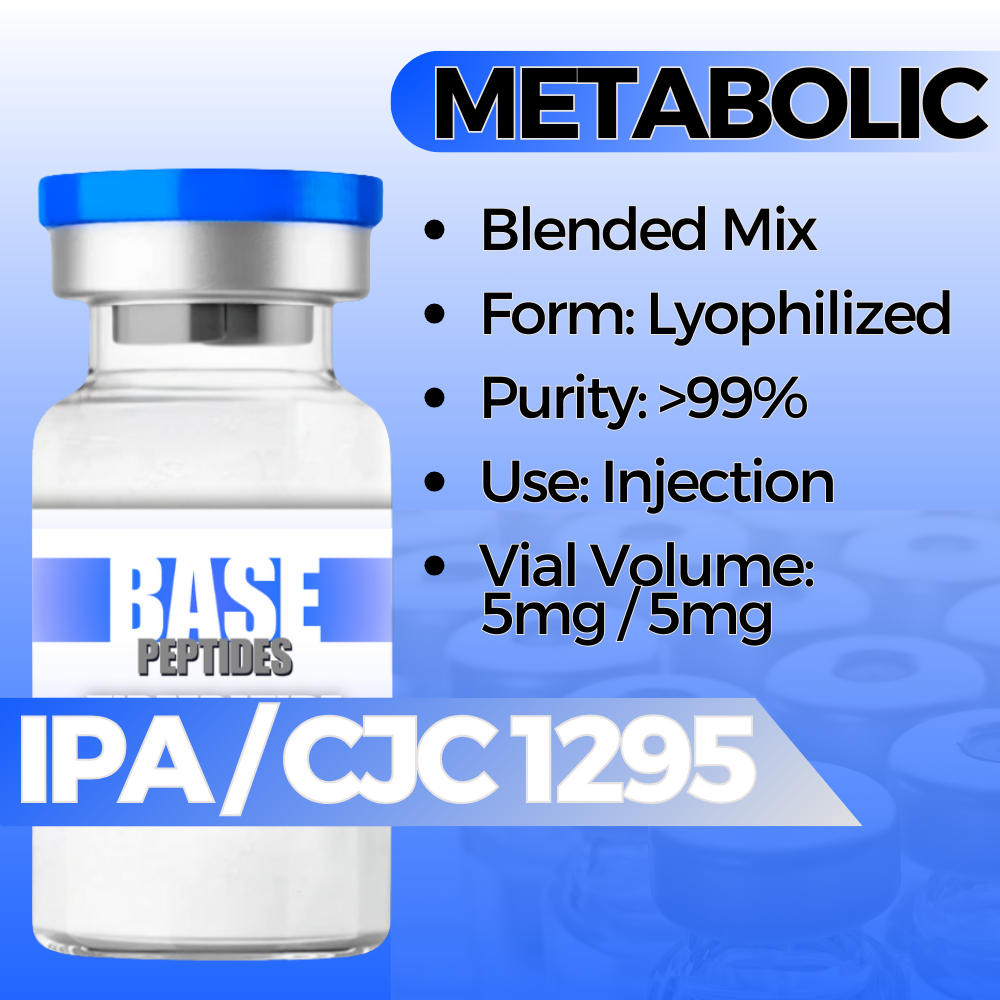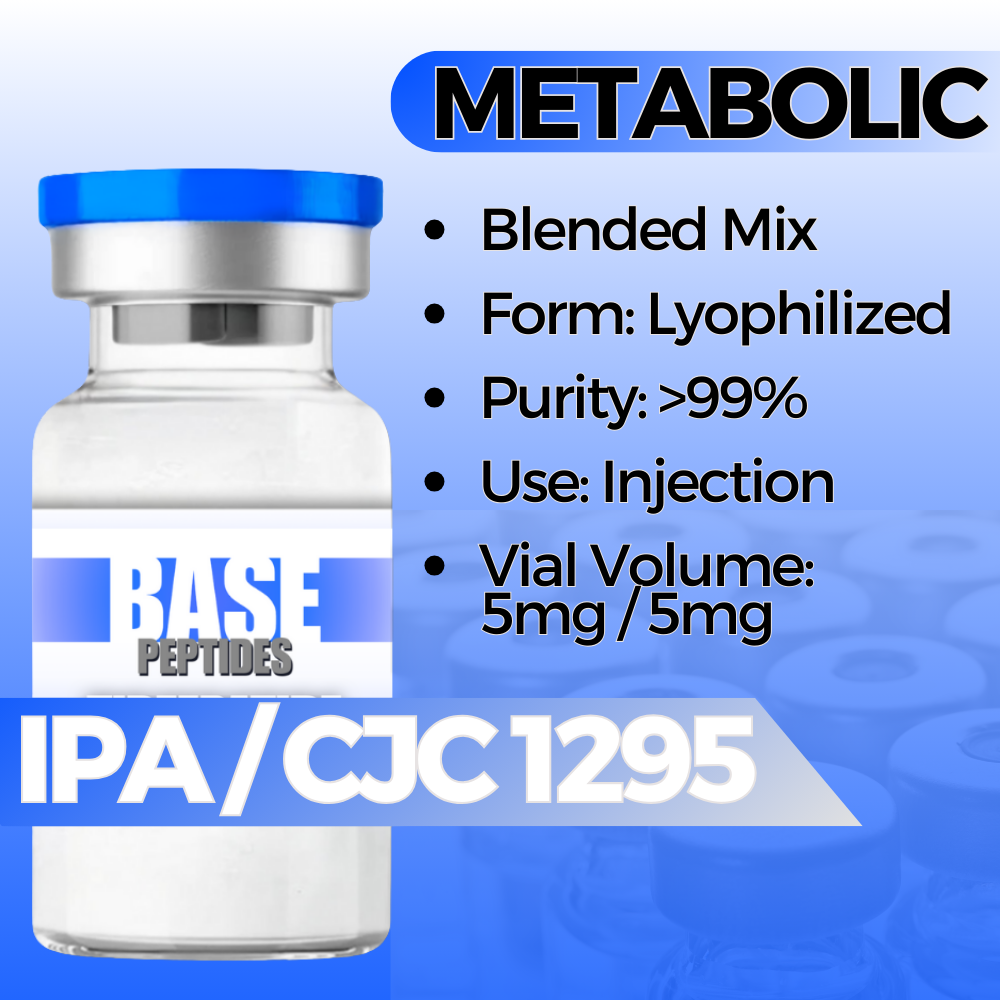Ipamorelin & CJC-1295
Ipamorelin & CJC-1295
Base Peptides are intended for licensed medical professionals and experienced researchers. Reconstitution required. Dosing and use instructions are not provided.
Regular price
$89.99
Regular price
Sale price
$89.99
Shipping calculated at checkout.
Quantity
Couldn't load pickup availability
Ipamorelin + CJC-1295 — Complementary GH Axis Research Blend
This combo pairs Ipamorelin (a selective ghrelin/GHSR-1a agonist) with CJC-1295 (a GHRH analogue, ±DAC). Together they’re used to study pituitary growth-hormone (GH) pulsatility, hypothalamic–pituitary regulation, and downstream IGF-1 biology in controlled research settings.
Component A — Ipamorelin
- CAS: 170851-70-4
- PubChem CID: 9831659
- Sequence (pentapeptide): Aib-His-D-2-Nal-D-Phe-Lys-NH2
- Notes: Highly selective for GH release with minimal ACTH/cortisol or prolactin effects vs older GHRPs.
Component B — CJC-1295 (GHRH analogue)
- Forms: CJC-1295 with DAC (albumin-binding “Drug Affinity Complex”) and CJC-1295 no DAC / Mod GRF(1-29).
- CAS (reported): with DAC 446262-90-4 ; no-DAC listings vary by substitution, commonly 446036-97-1 or 863288-34-0.
- Mechanism: Agonist at the GHRH receptor (GHRHR) on pituitary somatotrophs.
- PK note: DAC prolongs half-life via albumin binding; no-DAC behaves like short-acting GHRH(1-29) analogues.
Why Use the Combo (Plain English)
- Two switches, one output: CJC-1295 triggers the pituitary via GHRH, while Ipamorelin stimulates the ghrelin/GHSR pathway. Hitting both can amplify GH pulses vs either alone (synergy shown with GHRH + GHRPs/ghrelin).
- Clean signal: Ipamorelin is noted for selective GH release with low cortisol/prolactin cross-activation in studies—helpful for tidy readouts.
- Design flexibility: Choose no-DAC (short-acting pulses) or DAC (sustained exposure) to match your protocol window.
Key Study Themes — What’s Typically Tested
GHRH + GHS synergy on GH pulsatility
- What’s tested: Co-administration of a GHRH analogue with a ghrelin mimetic; serial GH sampling and deconvolution analysis.
- What changes: Greater peak GH and area-under-curve vs either agent alone in human and animal models.
- Why it matters: Models how dual hypothalamic inputs coordinate pituitary output, informing endocrine physiology and test paradigms.
Selectivity & endocrine “cleanliness” with Ipamorelin
- What’s tested: GH vs non-GH pituitary hormones under Ipamorelin exposure.
- What changes: Minimal effects on ACTH/cortisol or prolactin at GH-effective doses in classic work.
- Why it matters: Helps isolate GH/IGF-1 axes without confounding adrenal or lactotroph signals.
Potential Research Applications
Endocrine Physiology
- GH pulse profiling & deconvolution
- Somatostatin “tone” and feedback experiments
Translational Models
- IGF-1 kinetics and downstream signaling
- Body-composition and protein-turnover readouts (animal models)
Comparative Pharmacology
- CJC (DAC vs no-DAC) pulse vs exposure experiments
- Ghrelin mimetic selectivity comparisons
Blend Options (Research Configurations)
Standard
- 1:1 mass ratio (Ipamorelin:CJC)
- Balanced GH pulse amplitude + duration
Pulse-Forward
- 2:1 (Ipamorelin-heavy)
- Emphasis on sharp peaks for sampling studies
Exposure-Forward
- 1:2 (CJC-heavy; consider DAC)
- Emphasis on sustained GH/IGF-1 windows
Design Notes
- State form clearly (with DAC vs no-DAC) and vehicle/pH.
- Pre-specify sampling times (e.g., frequent early draws for peak capture).
- Document fed/fasted state and exercise, which modulate GH dynamics.
Synergistic Peptides (for Study Design)
MOTS-c
- Why pair: Energy-metabolism angle alongside GH/IGF-1 endpoints.
- Angle: Combine mitochondrial metrics with GH pulse analysis.
IGF-1/Mechano-Pathway Probes
- Why pair: Downstream pathway validation (e.g., AKT/mTOR phosphorylation).
- Angle: Tissue-specific signaling with controlled GH patterns.
Controls
- Include single-agent arms and vehicle to quantify additivity vs synergy.
- Consider somatostatin analog controls to probe counter-regulation.
Known Concerns (Context)
- Identifier variance (CJC): CAS numbers differ by form (DAC vs no-DAC) and specific substitutions; list the exact form in your methods.
- Assay design: GH biology is highly time-dependent; sparse sampling can miss peaks.
- General: Sold for laboratory research use only; not for human consumption, medical, or veterinary use.
Specifications & Handling
- Form: Lyophilized powders; blend ratio indicated on label
- Purity (each): ≥ 98–99% (HPLC/MS verified)
- Storage: ≤ −20 °C; dry, low-light; minimize freeze–thaw cycles
- In solution: Prepare fresh aliquots; record vehicle, pH, and time-course
- Packaging: Tamper-evident; research-only labeling
Regulatory & Use Notice
Sold for laboratory research use only. Not for human consumption, medical, or veterinary use. No human-use instructions are provided. Buyer is responsible for safe handling and regulatory compliance.
Ipamorelin + CJC-1295 Research Blend | Ghrelin (GHSR-1a) + GHRH Synergy | GH Pulsatility & IGF-1 Studies




